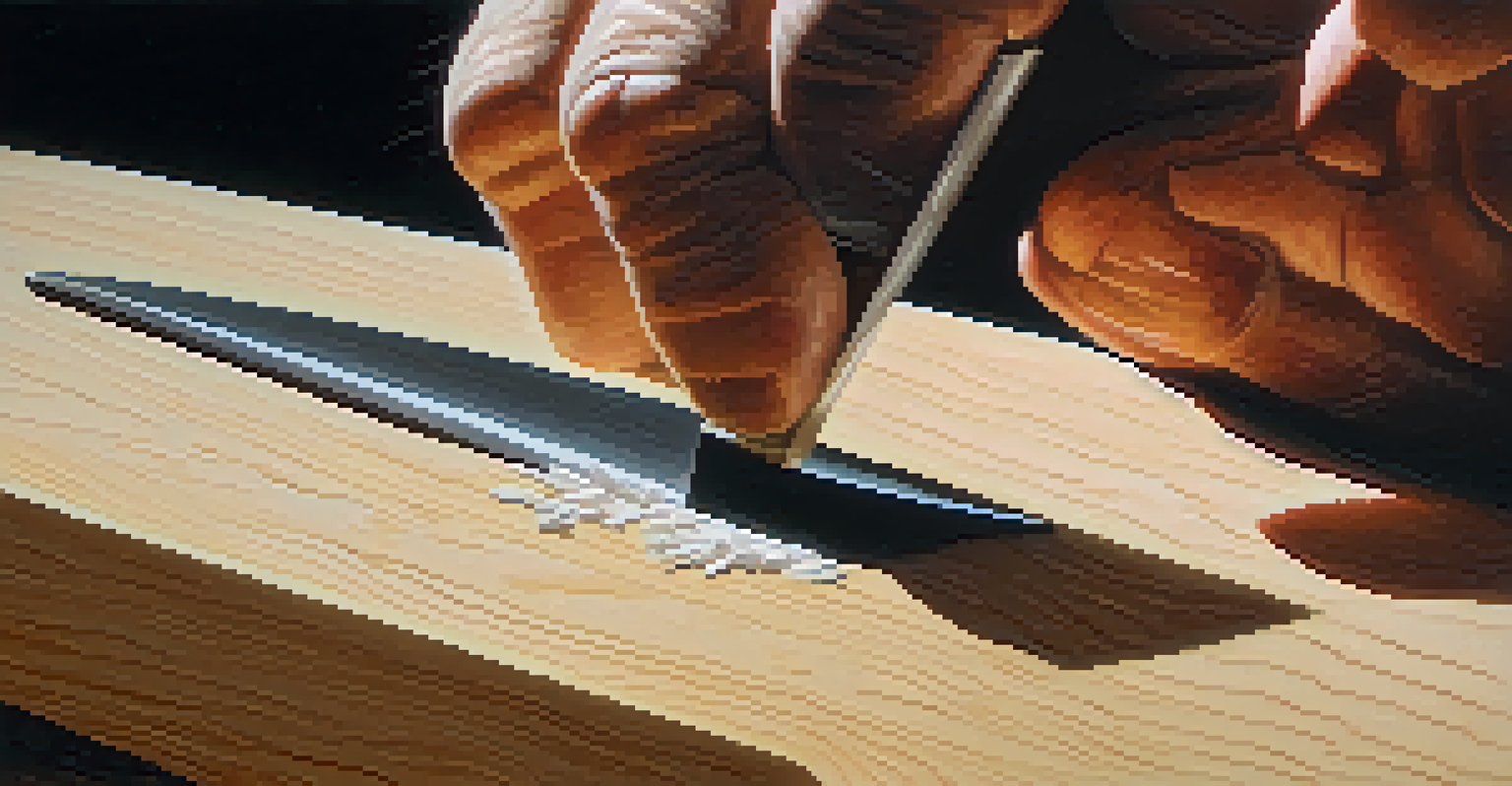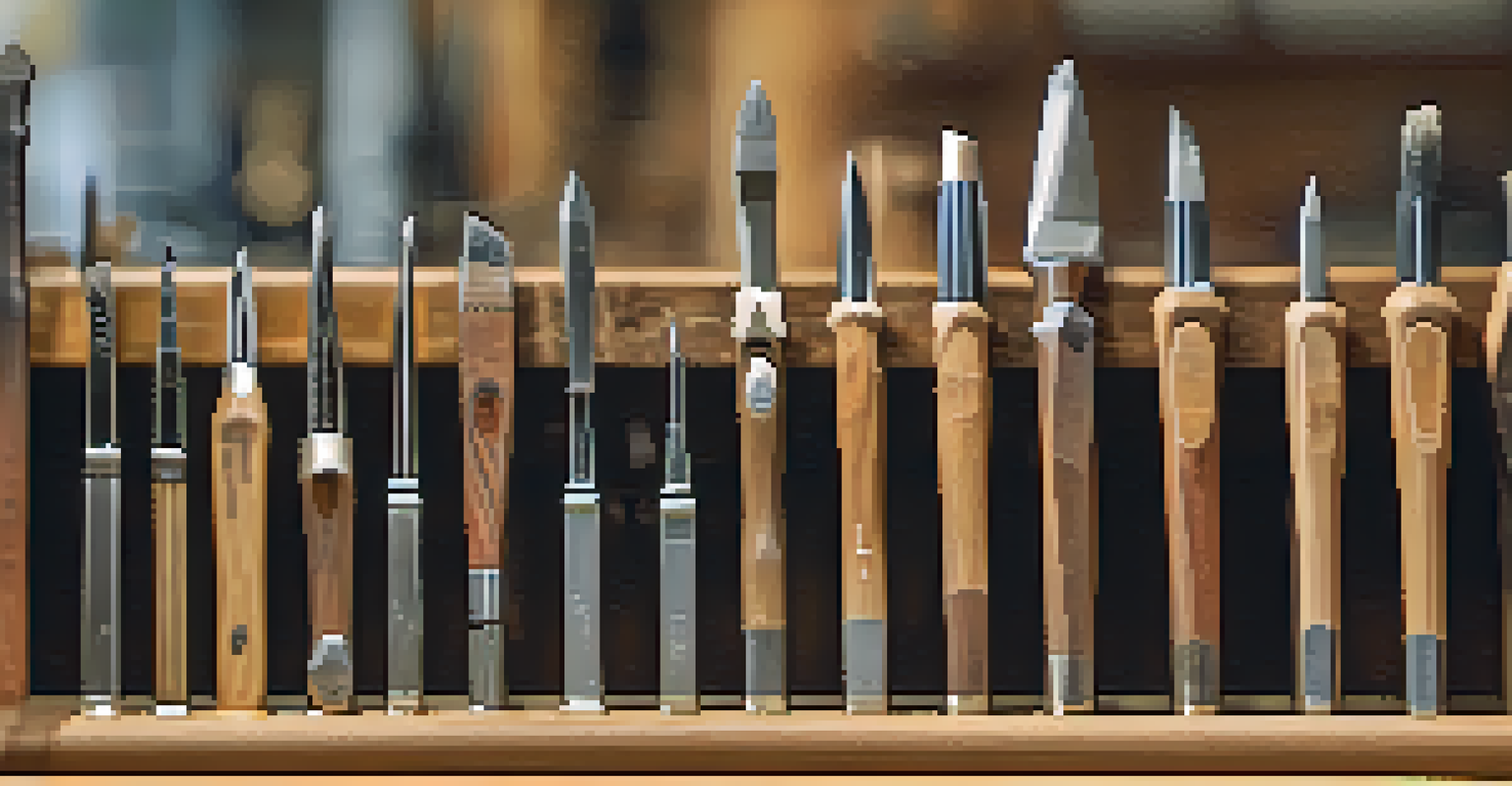Choosing the Right Chisel: Anatomy and Functionality

Understanding Chisel Anatomy: What You Need to Know
A chisel typically consists of a few key parts: the blade, handle, and tang. The blade is the metal portion that actually does the cutting, while the handle is where you grip the tool for control. The tang is the part of the blade that fits into the handle, providing stability during use.
The best designer knows that the most important tool is the one that feels good in your hand.
Different types of chisels have varying blade shapes and sizes, which affect their cutting functions. For example, a flat chisel has a straight edge for making grooves, while a skew chisel has a beveled edge for precise cuts. Understanding these components will help you choose the right chisel for your project.
The quality of materials used in the chisel also plays a significant role. High-quality steel blades retain their sharpness longer, making them more efficient for woodworking tasks. This investment pays off in the long run, saving you time and effort.
Different Types of Chisels and Their Specific Uses
There are various types of chisels designed for specific tasks, such as bench chisels, mortise chisels, and paring chisels. Bench chisels are versatile and great for general woodworking, while mortise chisels are specifically made for cutting square holes, known as mortises.

Paring chisels are long and thin, perfect for delicate work where precision is crucial. Each type serves a unique purpose, so knowing what you need for your project is essential in making the right choice.
Chisel Anatomy Matters
Understanding the key parts of a chisel, such as the blade, handle, and tang, is essential for effective woodworking.
For instance, if you're working on furniture that requires joints, a mortise chisel would be your best bet. On the other hand, if you're shaping wood or trimming edges, a bench chisel will do the trick. By matching the chisel to your specific task, you'll achieve cleaner and more professional results.
Choosing the Right Material for Your Chisel
Chisels are typically made from either carbon steel or high-speed steel. Carbon steel chisels are known for their sharpness and ease of sharpening, making them a favorite among many woodworkers. However, they can be less durable than their high-speed counterparts.
Quality is not an act, it is a habit.
High-speed steel chisels, on the other hand, are tougher and can withstand more wear and tear. They hold their edge longer but can be more challenging to sharpen. Understanding these material differences will guide you in selecting a chisel that suits your working style and project needs.
Ultimately, the choice between carbon and high-speed steel depends on your specific requirements. If you prioritize ease of sharpening and a fine edge, carbon steel might be the way to go. If durability is your main concern, high-speed steel could be worth the investment.
The Importance of Chisel Size for Your Projects
Chisel size is crucial and should align with the detail of your project. Sizes range from tiny 1/8-inch chisels for intricate work to larger 1-inch chisels for heavy-duty tasks. Choosing the right size helps ensure precision and efficiency in your woodworking.
For example, a small chisel is ideal for detailed carving or cleaning out joints, while a larger chisel can quickly remove material from larger surfaces. Using the appropriate size prevents damage to your work and allows for cleaner cuts.
Choosing the Right Chisel Type
Different chisels serve specific purposes, so selecting the appropriate type for your project can lead to more professional results.
Moreover, having a variety of sizes on hand is beneficial. This versatility allows you to tackle different tasks with ease, making your woodworking experience more enjoyable and productive.
Ergonomics: Choosing a Comfortable Chisel Handle
An often-overlooked aspect of chisels is the handle's ergonomics. A comfortable handle reduces fatigue during extended use, allowing you to maintain accuracy and control. Look for handles that fit well in your hand and provide a secure grip.
Some chisels feature wooden handles, while others may have plastic or rubber grips. Wooden handles offer a classic feel, while rubber grips can provide added comfort and traction. The choice largely depends on your personal preference and the type of work you intend to do.
Additionally, consider the handle shape; some are straight, while others may be contoured for better grip. Testing out different styles can help you find the perfect fit, ensuring your chiseling tasks are both efficient and enjoyable.
Maintaining Your Chisel: Tips for Longevity
Proper maintenance is key to ensuring your chisel lasts for years. Regular sharpening is essential, as a sharp chisel performs better and requires less effort. You can use sharpening stones, honing guides, or even electric sharpeners to keep your chisels in top condition.
In addition to sharpening, it's important to keep your chisels clean and free from rust. After each use, wipe the blade with a cloth and consider applying a light coat of oil to protect it from moisture. This simple step can greatly extend the life of your tool.
Proper Chisel Maintenance
Regular sharpening and proper storage are crucial for extending the lifespan of your chisels and ensuring optimal performance.
Finally, storing your chisels properly is crucial. A dedicated tool roll or a chisel rack keeps them organized and prevents accidental damage. By taking these maintenance steps, you'll ensure that your chisels are always ready for your next project.
Common Mistakes to Avoid When Choosing Chisels
One common mistake is buying a chisel set without understanding your specific needs. While having a variety of chisels can be beneficial, it’s better to invest in a few high-quality tools that you will actually use. Focus on the types of chisels that will serve your most frequent projects.
Another mistake is overlooking the importance of comfort and fit. A chisel that feels good in your hand can significantly impact your performance. Don't hesitate to try out different styles and shapes before making a purchase.

Lastly, neglecting maintenance can lead to premature wear and tear. Always prioritize proper care and storage for your chisels. By avoiding these common pitfalls, you can make better choices and enjoy your woodworking journey even more.